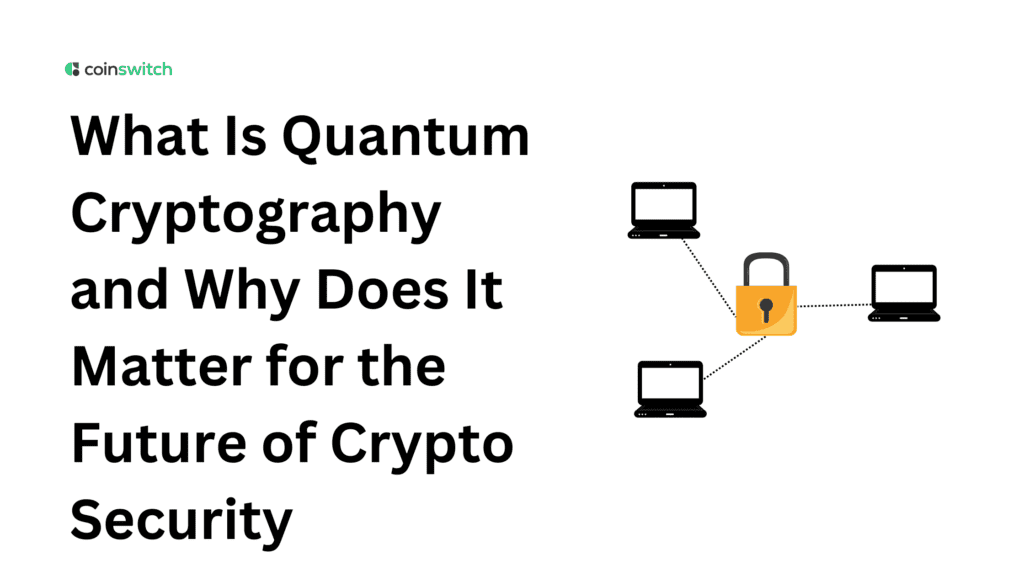How do crypto networks keep themselves secure in an age of security breaches and hacks? That is the billion-dollar question. Quantum cryptography is becoming integral to how crypto networks secure themselves in a fast-evolving digital landscape. As quantum computing advances at lightning speed, blockchain systems need tools that go beyond the math-heavy encryption models we use today.
Traditional cryptography works on the premise that some problems take forever to solve, at least for classical computers. Quantum computers throw that logic out the window. They can solve complex math in record time, putting wallet keys, smart contracts, and even consensus models at risk.
Quantum cryptography uses the laws of quantum mechanics to secure data. You get a system that flags snoopers immediately, keeps messages safe in transit, and builds a whole new way to think about encryption. It’s not a patch, it’s a redesign.
Crypto platforms are already moving in this direction. Quantum encryption helps with everything from wallet seed generation to validator communication. And as modular chains and layer-2 protocols grow, the need for unbreakable, fast-reacting security only gets bigger.
So, whether you’re building the next DeFi platform or just want to keep your coins secure for the long haul, quantum cryptography is something to watch.
Why is Quantum Cryptography Important?
Every transaction in crypto, sending coins, interacting with a smart contract, or participating in a DAO, depends on encryption. Without it, the whole system breaks. Right now, that encryption is safe because it takes classical computers way too long to crack. But quantum computers don’t play by those rules.
Quantum computers use algorithms, like Shor’s and Grover’s to solve complex math problems. Quantum cryptography changes the very foundation. The key advantage of these quantum algorithms is their ability to tackle problems that are intractable for classical computers. If anyone tries to peek into a message, the system knows about it immediately. The particles change state. The network reacts in real time.
This new model creates a kind of security that’s impossible to sneak past. For crypto, that means:
- Validators communicate without fear of man-in-the-middle attacks.
- Wallet seeds, also known as recovery or seed phrases, stay safe forever.
- Smart contract deployments remain locked down from tampering.
And that’s just the beginning. Even oracles, bridges, and governance systems benefit when data can’t be copied, read, or faked in transit.
Read More: The Crypto Decentralized Physical Infrastructure (DePIN) Narrative
Types of Quantum Cryptography
Quantum cryptography is a family of tools. Each one serves a different purpose, but together, they build an insanely secure environment. Let’s look at the major types in play right now.
Quantum Key Distribution (QKD)
QKD is a secure communication method that employs quantum mechanics to generate and distribute cryptographic keys, ensuring secure encryption for data transmission.
Practically speaking, QKD lets two parties share a secret encryption key using quantum bits (qubits). The key is created using particles like photons, which react the moment someone tries to observe them.
So here’s how it plays out: Alice wants to send Bob a secure key. They both use a quantum channel. If anyone tries to intercept that key, boom, the particles change. They both know the line got tapped, and they start fresh.
BB84 Protocol
This is a QKD protocol. Created in the 80s, this method is the original quantum key distributor. It uses polarized light to represent 0s and 1s. And it’s still relevant because it works in real-life setups.
E91 Protocol
This one uses quantum entanglement. Two particles stay linked, even if they’re on opposite sides of the world. If one changes, the other does too. It’s spooky, but insanely effective for ultra-secure key exchanges.
Quantum Random Number Generation (QRNG)
You need strong randomness to build good encryption. QRNG gives you true randomness pulled straight from quantum events. No patterns. No bias. Just pure unpredictability.
This is key for generating seed phrases, rotating authentication keys, and randomizing on-chain events like validator elections or slot assignments.
Quantum Secure Direct Communication (QSDC)
QSDC skips the key exchange altogether. Instead, you send the message itself using quantum bits. If someone tries to intercept it, the message self-destructs.
This model works great for high-stakes validator communication, private token swaps, and executive-level fund transfers between wallets.
Quantum Digital Signatures (QDS)
QDS lets you prove who sent a message, and that it hasn’t been altered. It’s a major upgrade for multi-signature wallets, DAO votes, and even airdrop validation.
Every message signed with QDS carries a quantum fingerprint. That’s tamper-proof. It also makes it easier to track signature origins without exposing the signer’s full identity.
Quantum Secret Sharing
This method splits secret information into quantum shares. You need a specific combination of these shares to reassemble the message.
Crypto teams use this to store treasury access, governance credentials, or private validator data across a group of trusted contributors.
Blind Quantum Computation
This allows a user to delegate computation to a quantum server without revealing the actual input or output. It’s helpful for privacy-preserving smart contracts and zero-knowledge proof systems.
Quantum tools keep evolving, but these techniques already offer powerful layers of protection and flexibility across every corner of the blockchain.
Read More: What is a Central Bank Digital Currency (CBDC)?
Post-Quantum Cryptography (PQC)
PQC refers to cryptographic algorithms that offer protection against attacks from both classical and future quantum computers.
Quantum encryption sounds exciting, but full quantum hardware still needs time to go mainstream. Meanwhile, there’s another path, Post-Quantum Cryptography (PQC). It’s all about building new math-based systems that can resist quantum attacks but still run on classical hardware.
PQC is here today. Projects don’t need quantum computers to implement it. They just upgrade their cryptographic tools. Think of it as future-proofing without waiting for the future.
Here are the top methods in play right now:
Lattice-Based Cryptography
This one leads the pack. Lattice problems are tough to solve, too tough for current quantum machines. Algorithms like Kyber, NTRU, and Dilithium use lattice models to build public-key systems and digital signatures.
These tools already passed early NIST rounds and are being tested in blockchains, encrypted messaging, and government-level systems.
Use cases include:
- Wallet key generation
- Blockchain node handshake encryption
- Validator credentialing
Code-Based Cryptography
Code-based systems rely on error-correcting codes. The best-known one is McEliece. The public keys are big, but the security is rock solid.
This model works great when platforms need high-speed validation or batch communication, like checking thousands of validator votes or minting NFT batches.
Multivariate Polynomial Cryptography
This one leans on complex algebra. It’s tough for both classical and quantum machines. Signature schemes like Rainbow use this method to lock down message integrity.
It’s perfect for:
- Identity verification in cross-chain transfers
- Document signing in enterprise-level chains
- Verifying off-chain computation results
Hash-Based Signatures
Simple. Efficient. Secure. Hash-based signatures use cryptographic hash functions to build a verifiable record of who signed what.
These signatures work well in:
- Permanent storage logs
- Smart contract history
- Legal record stamping
Supersingular Isogeny-Based Encryption
This one uses elliptic curves in a quantum-resistant way. It’s experimental, but people are exploring it for future applications in wallet key protection and encrypted chat tools for DeFi teams.
Hybrid Cryptographic Models
Some chains mix PQC and traditional cryptography. For example, a protocol might use Elliptic Curve Cryptography (ECC) today, but wrap it in a PQC envelope. That means when quantum gear finally arrives, the system doesn’t need a full reset.
Ethereum, Polkadot, and Tezos have already started exploring these hybrid models in their testnets and cryptographic research.
Open Source PQC Libraries
New toolkits make it easy for devs to start experimenting:
- liboqs: An open-source library backed by NIST-tested algorithms
- PQCrypto-VPN: Secures tunnels with PQC-ready tools
- RustCrypto: Working on modular PQC plug-ins for Web3 builders
You don’t have to build from scratch. The community’s already laying the groundwork.
Where PQC Meets DeFi and Web3
- Wallets use PQC to build safer recovery methods
- DeFi protocols use it to secure multisig layers.
- Bridges wrap messages with hash-based backups.
- DID systems test Rainbow and lattice signatures for future-proof KYC
Governments, startups, and universities are already getting involved. Agencies like NIST are publishing PQC standards. Companies like IBM and Microsoft run quantum-safe cloud projects. And crypto startups test PQC in cross-chain bridges, oracle data feeds, and NFT signatures.
The market’s moving.
Quantum cryptography and post-quantum encryption are reshaping the future of digital security. Together, they cover both ends of the spectrum: what to use when quantum gear lands, and what you can apply right now.
Web3 platforms, crypto wallets, and validators that get ahead of the curve today will be the ones setting the standard tomorrow.
Whether you’re writing smart contracts or safeguarding your long-term token stack, quantum security isn’t a maybe. It’s the new baseline.
FAQs
1. What is the meaning of quantum cryptography?
Quantum cryptography uses the principles of quantum mechanics to secure data transmissions. It enables parties to exchange encryption keys or data with protection that flags any interception attempt.
2. What are the main types of quantum cryptography?
The key types include Quantum Key Distribution (QKD), Quantum Random Number Generation (QRNG), Quantum Secure Direct Communication (QSDC), and Quantum Digital Signatures (QDS). Each method applies quantum properties differently to protect data.
3. How is quantum cryptography used in blockchain?
It secures node communication, wallet key generation, and smart contract interactions. It also supports identity systems and governance voting with physics-level protection.
4. What is post-quantum cryptography?
Post-quantum cryptography (PQC) develops new algorithms that can stand up to quantum computing threats using classical computing resources. It doesn’t depend on quantum channels, but still shields systems from quantum decryption.
5. Are there real-world projects using quantum cryptography?
Yes. Companies like ID Quantique and QNu Labs are developing and deploying QKD systems. Blockchain platforms have also begun testing post-quantum protocols within their development branches.








